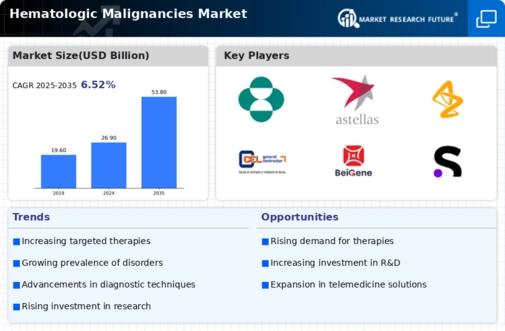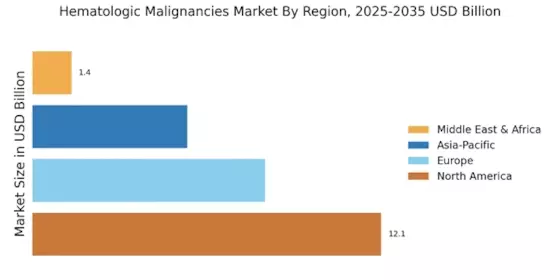Increased Focus on Immunotherapy
The growing emphasis on immunotherapy represents a transformative shift within the Hematologic Malignancies Market. Immunotherapeutic agents, such as CAR T-cell therapies and monoclonal antibodies, have shown promising results in treating various hematologic cancers. The market for immunotherapy is anticipated to expand significantly, with projections indicating a potential market size exceeding USD 50 billion by 2027. This surge is attributed to the increasing number of clinical trials and the successful approval of novel therapies. As more treatment options become available, healthcare providers are likely to incorporate immunotherapy into standard treatment regimens, thereby enhancing patient outcomes and driving growth in the Hematologic Malignancies Market.
Regulatory Support for New Therapies
Regulatory agencies are playing a pivotal role in shaping the Hematologic Malignancies Market by facilitating the approval of new therapies. Initiatives aimed at expediting the review process for innovative treatments, such as breakthrough therapy designations and accelerated approvals, are becoming increasingly common. This regulatory support is crucial for bringing novel therapies to market more swiftly, addressing the urgent needs of patients with hematologic malignancies. As a result, the market is likely to see a surge in the availability of new treatment options, which could enhance competition and drive down costs. The proactive stance of regulatory bodies is expected to foster a more dynamic and responsive Hematologic Malignancies Market.
Advancements in Diagnostic Technologies
Technological advancements in diagnostic tools are significantly influencing the Hematologic Malignancies Market. Enhanced imaging techniques, molecular diagnostics, and next-generation sequencing have revolutionized the detection and characterization of hematologic malignancies. These innovations enable earlier diagnosis and more accurate disease stratification, which are crucial for effective treatment planning. The market for diagnostic technologies is projected to grow, with estimates indicating a compound annual growth rate of over 10% in the coming years. As healthcare providers increasingly adopt these advanced diagnostic methods, the demand for targeted therapies and personalized treatment approaches is expected to rise, thereby driving the Hematologic Malignancies Market.
Growing Incidence of Hematologic Malignancies
The rising incidence of hematologic malignancies, such as leukemia, lymphoma, and myeloma, is a primary driver of the Hematologic Malignancies Market. According to recent statistics, the prevalence of these conditions has been steadily increasing, with estimates suggesting that over 1 million new cases are diagnosed annually. This surge in cases necessitates the development of innovative treatment options, thereby propelling market growth. Furthermore, the aging population is particularly susceptible to these malignancies, contributing to the overall increase in incidence rates. As healthcare systems strive to address this growing burden, investments in research and treatment modalities are likely to expand, further stimulating the Hematologic Malignancies Market.
Rising Investment in Research and Development
Investment in research and development (R&D) is a critical driver of the Hematologic Malignancies Market. Pharmaceutical companies and research institutions are increasingly allocating resources to discover and develop new therapies for hematologic malignancies. Recent data indicates that R&D spending in oncology has reached unprecedented levels, with hematologic cancers receiving a substantial share of this investment. This focus on innovation is likely to yield novel treatment options, including targeted therapies and combination regimens, which could significantly improve patient outcomes. As the pipeline for new drugs expands, the Hematologic Malignancies Market is expected to experience robust growth, driven by the introduction of these advanced therapies.


















Leave a Comment